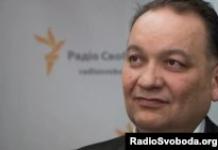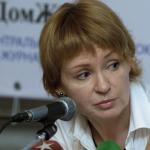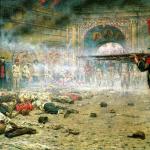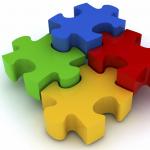Thinking and intelligence are terms that are similar in content. Both terms express different aspects of the same phenomenon. A person endowed with intelligence is capable of carrying out thinking processes. Thinking and intelligence have always been the hallmarks of man, because we call man Homo sapiens - reasonable man. However, the concept of intelligence is broader than the concept of thinking. Scientists cannot give a single definition of intelligence. Everyone puts their own nuance into this concept. Some researchers focus on the fact that intelligence is the ability to acquire new knowledge and skills, while others study the social aspects of intelligence. Today in science there are two most common definitions of intelligence:
intelligence - the ability to adapt to the environment; intelligence - the ability to solve mental problems.
Many psychologists note that intelligence has a complex structure. What is included in the structure of intelligence - there are many answers to this question.
At the beginning of the 20th century. Spearman came to the conclusion that each person is characterized by a certain level of general intelligence (he called it the G factor). General intelligence determines how a person adapts to his environment. In addition, all people have developed specific abilities to varying degrees, which manifest themselves in solving specific problems of adaptation to the social environment. Subsequently, G. Eysenck interpreted the concept of general intelligence as the speed of information processing by the central nervous system (mental pace). However, the hypothesis of the “speed of information processing by the brain” does not yet have serious neurophysiological arguments.
Today, the most famous is D. Guilford’s “cubic” model of intelligence. He believed that intelligence can be described in three main categories:
- 1) operations;
- 2) content;
- 3) results.
Cattell distinguishes potential and crystalline intelligence. He believes that each of us already has a potential intelligence from birth, which underlies our ability to think, abstract and reason. Around the age of 20, this intelligence reaches its greatest flowering. On the other hand, crystalline intelligence is formed,
Rice. 1.
consisting of various skills and knowledge that we acquire as we gain experience in life. Crystal intelligence is formed precisely when solving problems of adaptation to the environment and requires the development of some abilities at the expense of others, as well as the acquisition of specific skills. Thus, crystalline intelligence is determined by the measure of mastery of the culture of the society to which a person belongs. Potential intelligence determines the primary accumulation of knowledge. From Cattell's point of view, potential intelligence is independent of upbringing and environment. It depends on the level of development of the tertiary zones of the cerebral cortex.
Hebb views intelligence from a slightly different perspective. He highlights intelligence A - this is the potential that is created at the moment of conception and serves as the basis for the development of an individual’s intellectual abilities. As for intelligence B, it is formed as a result of a person’s interaction with the environment. To date, only intelligence B has been learned to be assessed by observing how a person performs mental operations. So far, scientists have not found a way to assess A.'s intelligence.
Disputes about the structure of intelligence are not accidental. They are not only of scientific interest, but also help answer the question that worries everyone - what factors determine the development of intelligence.
Today, scientists agree that the development of intelligence depends both on congenital factors and on upbringing and the child’s environment. Hereditary factors, chromosomal abnormalities, malnutrition and illnesses of the mother during pregnancy, abuse of antibiotics, tranquilizers or even aspirin in the first months of pregnancy, drinking alcohol and smoking can lead to a significant delay in the mental development of the child. But no matter what potential a child is born with, it is obvious that the forms of intellectual behavior necessary for his survival can develop and improve only through contact with the environment with which he will interact throughout his life. The richer and more varied the child’s communication with the people around him, the more successful the development of his intellect will be. In this regard, the role of the family’s social status becomes clear. Wealthy families have greater opportunities to create favorable conditions for the development of the child, the development of his abilities, his education and, ultimately, to increase the intellectual level of the child. The teaching methods used to develop the child’s abilities also have an impact. Unfortunately, traditional teaching methods are more focused on transferring knowledge to the child and pay relatively little attention to the development of a person’s abilities, intelligence, and creativity.
Despite the fact that many equate the concepts of intelligence and thinking, there is a difference between them. While thinking is a designation for human mental activity, intelligence is the ability for this process. The following difference: thinking is a basic innate complex of cognitive capabilities, intelligence is a more complex structure that can be developed. At the same time, thinking, as a basic component of intelligence, can develop simultaneously with it.

Intelligence
There are many definitions. It characterizes the following abilities:
- cope with new or difficult situations;
- learn from experience;
- adapt to new circumstances;
- adaptive behavior in the context of changing conditions.
In addition to the definition of the concept of intelligence, there are differences in the opinions of scientists even on whether it should be understood as one whole, or whether it is divided into several relatively different types.
For example, according to the theory of American psychologist Robert J. Sternberg, intelligence consists of 3 components:
- analytical thinking, mainly involved in solving problems that a person has encountered in the past;
- creative thinking used to find ways to solve problems;
- practical thinking related to everyday life.
His colleague, Howard Gardner, identifies 8 types of thinking and intelligence:
- linguistic;
- logical-mathematical;
- visual-spatial;
- motor;
- musical;
- interpersonal;
- intrapersonal;
- natural.
Later he identified the 9th type, the so-called. existential intelligence.
Edward Thorndike identifies only 3 main types of intelligence:
- theoretical (abstract);
- practical (specific);
- social – the ability to control others (includes emotional intelligence).
From the listing of the above-mentioned components, it becomes clear that some of them have a greater connection with the theoretical part of life (education), others with the practical (work experience, the art of coping with life). The ability to achieve high incomes is a matter of practical application of theoretical knowledge acquired through study, observation, and education. Both the first part (acquiring knowledge) and the second (the ability to apply it in practice) can fail. Some people who have good thinking and intelligence do not receive an education that matches their IQ level. Reasons can range from financial, geographical, political factors to excessive criticism of teachers.
Social intelligence is also important. It includes the ability to process, recognize, control emotions, build quality, long-term relationships, and collaborate with others. Social skills have a significant impact on obtaining jobs or lucrative orders. Success is predetermined by the following skills:
- appeal to people;
- impression;
- good work in a team and with superiors;
- creating an appropriate network of contacts and acquaintances;
- penetration into the secrets of the organizational structure;
- understanding the written and unwritten rules of behavior in the new team.
Relationship between mental and emotional intelligence
(EI) is a person’s ability to realize, identify (reflect), manage their emotions, understand the emotions of other people, and effectively influence them. These abilities, according to experts, are the most important for life.

In management practice, EI is underestimated; in companies and organizations it is still customary to look at successful performance results as the fruits of high mental qualities of employees. In fact, a person's feelings and emotions (as well as their relationship with the mind) are very important. They influence what gets our attention, how we think, and what we decide. For example, a hungry person in a shopping center sees food, a well-fed person sees shoes, books.
The relationship between mental and emotional intelligence has not yet been fully correlated. But many interesting things are already known. A person’s creative abilities and successful activities are the result of his productive thinking, the essence of which is complex. These qualities are not due only to high mental abilities. They are the result of a combination of rational thinking ability and EI proportional to the nature of the situation.
The characteristics of thinking and intelligence in psychology suggest that very smart people do not always have highly productive thinking. Their productive thinking may be lower than that of the average intelligent person.
When mental intelligence is high, creative and productive thinking is low.
People who score more than 120 on IQ tests have only a 5-15% chance of successful leadership. They do not have a good ability to inspire and motivate other people.
Thinking
Thinking is one of the cognitive processes. It is mainly about working with information, ideas, concepts. Thinking allows a person to find correlations and solve problems.
Functions of thinking:
- formation of concepts;
- recognition and search for relationships;
- problem solving;
- creating something new.
The result is new information, experience, knowledge.
Properties
With regard to thinking, several properties are distinguished:
- Convergence. The ability to stick to a specific topic, follow the line of logical context.
- Divergence. Also called artistic, creative thinking, characterized by a wide range of possibilities.
- Worldview. Determines how much knowledge and problems a person can incorporate or solve in their thinking.
- Depth. Determines the extent to which a person can go into detail about a problem (for example, through analysis).
- Accuracy (reliability). Determines how logical, practical, and correct the ideas are.
- Independence. The ability to solve problems may be more or less dependent on the help of other people.
- Flexibility. The ability to break away from thought patterns and find the most effective solution to a given problem (for example, overcoming functional fixation).
- Criticality. The ability to conduct a critical analysis of individual knowledge and the process of solving a problem.
Types
Thinking is divided into several types according to various parameters.
Concrete VS Demonstrative VS Abstract:
- Concrete - directly refers to practical subjects, a person thinks that he will do. This option is impractical, time-consuming, and tedious.
- Indicative - before starting to do something, a person imagines how it will happen. This option is more practical and faster.
- Abstract - a person does not imagine any objects, thinks abstractly. This is how, for example, mathematical equations are solved.
Analytical VS Synthetic:
- Analytical - analyzes the whole thing, divides it into smaller parts, which it analyzes again.
- Synthetic - combining knowledge and facts into one concept.
In practice, both types are often used.
Convergent VS Divergent:
- Convergent – searching for one correct solution.
- Divergent – search for all possible solutions.
Due to the similarity of these types, they are also often used together - first divergent thinking, then convergent thinking.

Reasoning
It is a thinking process in which conclusions are based on information.
Ways of reasoning:
- Deduction is the subtraction of conclusions for a specific case from general rules (one is determined from the set). Example: Socrates is a man → man is mortal → Socrates is mortal. Deduction never brings any new information.
- Induction - goes in the opposite direction than deduction - from one to many. It is a matter of establishing general rules based on specific cases. Example: Peter has a car → Alexander has a car → all men have cars. Inductive judgments are always applied only with a certain probability, never with 100%. All scientific theories are based on inductive reasoning.
Thinking and problem solving
Mental operations are purposeful mental manipulation of mental content aimed at solving both theoretical and practical problems.
Mental operations are divided into 2 categories:
- Logical operations are governed by precise rules that should not be violated. In the process of solving a problem, a person follows an algorithm (just like a computer). The solution is correct and accurate. However, in everyday life this is an impractical and time-consuming path.
- Heuristic operations are abbreviated thinking practices that lead to results without individual consideration of all options and alternative approaches. The results are assessed in terms of suitable/unsuitable. This option is extremely fast and efficient compared to the previous one, but it is also saddled with a high error rate.
Does the correctness of decision making depend on the degree of thinking and intelligence?
Reason is not always the key to making good decisions. The British online publication Independent reports this, citing the scientific journal Research Digest. A high IQ can lead to academic success, but good decisions are made through critical thinking, without undue emotional burden.

Probably every person has a friend or acquaintance who has an extraordinary mind, but at the same time commits many stupid things: either slams the keys in the car, or falls for Internet fraud.
According to new research cited by the author of an article in the Independent, a high IQ does not necessarily mean that a person has good critical thinking.
Disorders of thinking and intelligence
Mental disorders belong to the field of psychiatry and can be congenital or acquired:
- congenital pathology – oligophrenia;
- acquired pathology – .
In both cases, sick people are characterized by a disorder of thinking ability, often of daily physical activity, and independence.

AI Philosophy
The philosophy of artificial intelligence (AI) is a branch of philosophy that attempts to answer the following questions:
- What is the essence of intelligence? Can a machine completely replace the thinking of the human mind?
- Is the nature of a computer and the human brain the same? What methods does the human brain use to create consciousness (or at least the illusion of it)?
- Can a machine have a mind, mental states, consciousness similar to that of a human? Can a machine feel?
These three questions regarding thinking and intelligence in philosophy reflect the different interests of AI scientists. The scientific answer to these questions depends entirely on the definitions used of “intelligence,” “consciousness,” and “machine.”
Phylogenetic aspect (or phylogeny of thinking) involves the study of how human thinking developed and improved in human history. IN phylogenythinking and speech, a pre-speech phase in the development of intelligence and a pre-intellectual phase in the development of speech clearly emerges.
Sociogenesis V psychology- origin and development consciousness, personalities, interpersonal relationships, due to the features socialization in different cultures and socio-economic formations.
In psychology ontogenesis- formation of the basic structures of the individual’s psyche during his childhood; the study of ontogenesis is the main task of child psychology.
By stage of development in ontogenesis:
Visual-effective thinking(the first genetic stage of development of mental activity. The child directly perceives an object and performs practical actions with it);
Visual-figurative thinking(the second genetic stage of thinking. The search for the unknown is carried out through the identification of hidden connections, properties and possible transformations of the elements of the object’s image);
Verbal and logical thinking(A person operates with concepts and logical constructs that function on the basis of language).
44. Thinking and intelligence
Intelligence - with the totality of human mental abilities ensuring the success of his cognitive activity. In a broad sense, this term refers to the totality of all cognitive functions of the individual(perception, memory, imagination, thinking), and in a narrow sense - his mental abilities1. In psychology there is a concept of the structure of intelligence, however, the understanding of this structure varies widely depending on
Thinking and intelligence are terms that are similar in content. Their relationship becomes even clearer if we switch to everyday speech. In this case, the word “mind” will correspond to intelligence. We say “smart person”, denoting individual characteristics of intelligence. We can also say that “the child’s mind develops with age” - this conveys the problem of intellectual development. We can associate the term “thinking” with the word “deliberation.” The word “mind” expresses a property, an ability, and “deliberation” expresses a process. Thus, both terms express different aspects of the same phenomenon. A person endowed with intelligence is capable of carrying out thinking processes. Intelligence is the ability to think, and thinking is the process of realizing intelligence.
In psychology there is a concept structures of intelligence , however, the understanding of this structure varies widely depending on the views of a particular psychologist. For example, a famous scientist R. Cattell distinguished two sides in the structure of intelligence: dynamic - “fluid” (fluid) and static - “crystallized” (crystallized). According to his concept, “fluid intelligence” manifests itself in tasks whose solution requires quick and flexible adaptation to a new situation. It depends more on the person's genotype. “Crystallized intelligence” is more dependent on the social environment and manifests itself when solving problems that require relevant skills and experience.
You can use other models of the structure of intelligence, for example, highlighting the following components in it:
ability to learn (quickly master new knowledge, skills and abilities);
the ability to successfully operate with abstract symbols and concepts;
ability to solve practical problems and problem situations;
the amount of available long-term and working memory.
Accordingly, intelligence tests include several groups of tasks. These are tests that reveal the amount of knowledge in a certain area; tests that evaluate a person’s intellectual development in connection with his biological age; tests that determine a person’s ability to solve problem situations and intellectual tasks. In addition, there are special tests. For example, on abstract-logical or spatial thinking, on verbal intelligence, etc.
The most well-known tests of this type include:
Stanford-Binet test- assesses the child’s intellectual development;
Wechsler test- assesses the verbal and non-verbal components of intelligence;
Raven's test- non-verbal intelligence;
Eysenck test (IQ)- determines the general level of intelligence development.
Send your good work in the knowledge base is simple. Use the form below
Students, graduate students, young scientists who use the knowledge base in their studies and work will be very grateful to you.
Posted on http://www.allbest.ru/
Posted on http://www.allbest.ru/
Federal Agency for Railway Transport
Baikal-Amur Institute of Railway Transport
branch of the federal state budgetary educational institution
higher professional education "FEGUPS" in Tynda
Department of Accounting and Audit
TEST
discipline: "Psychology"
Topic: “Thinking and Intelligence”
Completed by: 3rd year student Daria Sergeevna Konovalova
BU&A specialties
Tynda 2014
Introduction
Human intelligence, or the ability of abstract thinking, is one of the most important essential properties of a person. Man is a microcosm, in an abbreviated and generalized form, carrying within itself the infinite variety of the material world.
The essence of man as a microcosm determines the meaning of human existence, the meaning of his work and intellectual creativity. The meaning of human existence is not outside of man, but in human existence itself, in the production, creation of one’s being and one’s essence.
The development of human essence occurs in the process of transforming the natural environment, creating a “second nature” (K. Marx). Consequently, it also has its own “external guidelines” - the exploration of the world in breadth (expansion into space) and in depth.
More specifically, the meaning of human existence should be presented as an endless complication and enrichment of the creative nature of labor and the creative abilities of the human intellect. The greatness and dignity of a person lies in the endless possibilities of his work and intellect.
The immediate predecessor of human intelligence is the so-called “concrete thinking”, or thinking in “concrete”, sensory images (I.M. Sechenov, I.P. Pavlov). The nature, structure and “logic” of concrete thinking are still very poorly understood. It is generally accepted that the psyche of higher animals is based on two main types of reactions - instincts and temporary connections (associations). Instincts are innate, inherited species forms of behavior and reflections of the environment, developed as a result of many millennia of biological evolution. Associations are of a lifetime nature, formed as a result of individual adaptation to the environment, and constitute the individual lifetime experience of the animal. Associations are a reflection of external connections between various environmental phenomena perceived by animals - sounds, smells, etc. Instincts and associations, in their complex form, are also part of the human psyche, forming the humanized biological foundation of his consciousness and intellectual activity. Human instincts include the basic, generalizing instinct of life (or self-preservation), motor, sexual, related, and cognitive instincts.
Apes and, more broadly, higher animals have the ability to form a kind of knowledge. “Catching the normal connection of things.” How do these kinds of reactions or connections in the psyche (associations) of animals differ from conditioned reflexes? A conditioned classical reflex is a nervous connection between two points of the cerebral cortex, fixing (displaying) the connection of any external phenomenon (sound, smell, etc.), acting as an external stimulus indifferent to the body, with another, directly biologically significant for the body ( food, enemy, etc.). In itself, a phenomenon that is indifferent to the body and has no immediate biological significance (for example, a bell), associated with the appearance of food, becomes a signal of food, an unconditional stimulus, and therefore acquires biological significance for the body. The connection between the bell and food is of the nature of a temporary coincidence, i.e., an external connection. However, the signal connection has an objective “meaning” for the animal, because it indicates the appearance of food, an enemy, etc. Therefore, the conditioned reflex is not some simple mechanical connection of completely heterogeneous events and can serve as a genetic prerequisite for the formation of more complex, psychological connections, meaning the formation of knowledge , “capturing the normal connection of things.”
In connections of the type called I.P. Paul's education of knowledge displays the external, not the causal, essential connections of things, but in these external connections the necessary, essential connections are expressed and “shine through,” because the biological significance of external phenomena is not accidental, essential. An animal thinks in sensory images, and not in concepts, which are the only ones capable of grasping the essential aspects of reality. However, implicitly, in a hidden and unconscious form, this knowledge reflects the essential aspects of reality. The adaptive mode of existence of an animal determines direct knowledge of phenomena, while the essential side of real phenomena remains hidden.
The essence of life lies outside the removable tendency of the living to self-preservation, carried out through adaptation, adaptation to the environment. For an adaptive way of existence, a reflection of the external aspects of reality is necessary and sufficient. Man arises as a result of the natural development of the internal contradiction of life: the absolute tendency of the living towards self-preservation “takes” the living beyond the limits of the relatively “weak” and limited method of activity - adaptation to the environment and gives rise to a more effective and powerful way of activity - the transformation of the environment, the production of one’s own own existence, characteristic of man as the highest form of matter.
thinking abstraction intelligence
1. The relationship between the concepts of “thinking” and “intelligence”
Thinking and intelligence are terms that are similar in content. We can associate the term thinking with the word deliberation. The word mind expresses the property, ability, thinking process. Thus, both terms express different aspects of the same phenomenon. A person endowed with intelligence is capable of carrying out thinking processes. Intelligence is the ability to think, and thinking is the process of realizing intelligence. Thinking and intelligence have long been considered the most important distinguishing features of a person. It is not without reason that the term Homo sapiens is used to define the type of modern man.
Thinking as cognition that goes beyond the immediate given is a powerful sign of biological adaptation. It was thanks to intelligence that man took a dominant position on Earth and received additional means for survival. However, at the same time, human intelligence has also created colossal destructive forces. From an individual point of view, there is essentially a threshold relationship between intelligence and performance success. For most types of human activity, there is a certain minimum intelligence that ensures the ability to engage in this activity.
2. Types of thinking. Forms of thinking. Operations of thinking
Types of thinking
Thinking is a special kind of theoretical and practical activity that involves a system of actions and operations of a transformative and cognitive nature included in it.
Theoretical conceptual thinking is such thinking, using which a person, in the process of solving a problem, refers to concepts, performs actions in the mind, without directly dealing with the experience gained through the senses. He discusses and searches for a solution to a problem from beginning to end in his mind, using ready-made knowledge obtained by other people, expressed in conceptual form, judgments, and inferences. Theoretical conceptual thinking is characteristic of scientific theoretical research. Theoretical figurative thinking differs from conceptual thinking in that the material that a person uses here to solve a problem is not concepts, judgments or inferences, but images. They are either directly retrieved from memory or creatively recreated by the imagination.
This kind of thinking is used by workers in literature, art, and in general people of creative work who deal with images. In the course of solving mental problems, the corresponding images are mentally transformed so that a person, as a result of manipulating them, can directly see the solution to the problem that interests him. Both types of thinking considered - theoretical conceptual and theoretical figurative - in reality, as a rule, coexist. They complement each other quite well, revealing to a person different but interconnected aspects of existence. Theoretical conceptual thinking provides, although abstract, but at the same time the most accurate, generalized reflection of reality.
Theoretical figurative thinking allows us to obtain a specific subjective perception of it, which is no less real than the objective-conceptual one. Without one or another type of thinking, our perception of reality would not be as deep and versatile, accurate and rich in various shades as it actually is. Visual-effective thinking is genetically the earliest form of thinking. Its first manifestations in a child can be observed at the end of the first - beginning of the second year of life, even before he masters active speech. Visual-figurative thinking - manifests itself in preschoolers aged 4-6 years.
The connection between thinking and practical actions (as in visual-action) is preserved, but not as direct as before. Characterized by reliance on ideas and images, the functions of figurative thinking are associated with the presentation of situations and changes in them that a person wants to obtain as a result of his activities. A very important feature of imaginative thinking is the formation of unusual, incredible combinations, objects and properties.
Verbal-logical thinking is thinking in the form of abstract concepts. Thinking now appears not only in the form of practical actions, and not only in the form of visual images, but in the form of abstract concepts. This type of thinking is carried out using logical operations. Realistic thinking is aimed at the outside world, regulated by logical laws.
Autistic thinking is associated with the realization of a person’s desires (when what is desired is presented as reality).
Egocentric thinking is the inability to accept another person's point of view.
Forms of thinking
The main elements with which thought operates. There are concepts, judgments, inferences, also images and ideas. A concept is a thought. Which reflects the most common ones. Essential and distinctive (specific) signs of objects and phenomena of reality. For example, the concept of a person includes such essential features as labor activity, production of tools, and articulate speech. All these essential essential properties distinguish humans from animals. The content of concepts is revealed in judgments. Which are always expressed in verbal form - oral or written, out loud or silently. Judgment is a reflection of the connections between objects and phenomena of reality or between their properties and characteristics.
Depending on how judgments reflect objective reality. They are true or false. A true judgment expresses the connection between objects and their properties that exists in reality. Judgments can be general, particular and individual. In general judgments, something is affirmed (or denied) regarding all objects of a given group, a given class. Judgments are formed in two main ways: 1) directly, when they express what is perceived, 2) indirectly - through inference or reasoning. There are two main types of inferences - inductive and deductive. Induction is inference from particular cases, examples, etc. to the general position (to the general judgment). Deduction is an inference from a general position (judgment) to a particular case, fact, example, phenomenon.
Operations of thinking
The mental activity of people is carried out with the help of mental operations: comparison, analysis and synthesis, abstraction, generalization, concretization. Comparison is a comparison of objects and phenomena in order to find similarities and differences between them. Comparison, comparison leads to classification. So, in a library, books can be classified by content, genre, etc. Analysis is the mental division of an object or phenomenon into its constituent parts or the mental isolation of individual properties, features, and qualities in it. For example, in a plant we distinguish the stem, root, flowers, leaves, etc. In this case, analysis is the mental decomposition of the whole into its constituent parts.
Synthesis is the mental connection of individual parts of objects. If analysis provides knowledge of individual elements, then synthesis, based on the results of analysis, combining these elements provides knowledge of the object as a whole. So, when reading, individual letters, words, phrases are highlighted in the text and at the same time, they are continuously connected with each other: letters are combined into words, words into sentences, sentences into sections of the text. Analysis and synthesis are interconnected. Abstraction is the selection of one aspect of a property and abstraction from the rest. Thus, when examining an object, you can highlight its color without noticing its shape, or, conversely, highlight only its shape. For example, the concept that we express with the word fruit combines similar characteristics that are found in plums, apples, and pears. Generalization is the ability to combine similar features of objects and phenomena.
3. Thinking process
Thinking involves creating a model of a problem situation and drawing conclusions within this model. The model is not created from scratch. And from building elements, various structures of knowledge representation located in long-term memory. From these elements in the field of attention, a model is created. Relevant only to this task. Thinking in this way is a complex process, involving numerous mental structures and processes. The first theory describing the thinking process was proposed back in the 19th century within the framework of associative psychology. Associationists believed that mental life is determined by the struggle between individual elements (ideas for a place in consciousness).
The volume of consciousness is limited. It can contain a small number of elements at the same time. Elements attract certain others to themselves. That is, they are trying to introduce it into the field of consciousness. If you are there yourself. This attraction between elements (association) occurs either as a result of shared past experience or similarity. Associationists describe the thought process roughly as follows. When the subject receives a task, the field of consciousness simultaneously includes conditions, tasks and the goal that needs to be achieved. The condition of the task and the goal will contribute to the fact that such a middle element will fall into the field of consciousness, which is associated with both the condition of the task and the goal.
In modern cognitive psychology, two stages are usually distinguished in the thinking process - the stage of creating a model of a problem situation and the stage of operating with this model, understood as a search in the problem space. Although, it seems, this division is quite arbitrary. The model of a problem situation does not arise out of nowhere; structures and knowledge schemes located in long-term memory are involved in its creation. The same processes of searching and retrieving knowledge occur here as those considered by memory researchers. The difference is that the process of thinking requires the creation of a new model from known elements, while memory involves simply retrieving what was embedded in it.
4. Thinking and creativity
Thinking is closely connected with the discovery of new things, with creativity. However, creativity cannot be identified with thinking. Thinking is one of the types of cognition. Creativity is possible not only in knowledge. The clearest example of creativity is in art. The basis of art is the creation of beauty. This often requires knowledge, but it is not the essence of beauty. The creative process is related to the characteristics of the tasks. In the case of scientific creativity, the task is knowledge, in the case of art, it is creation. In this regard, the work of an engineer approaches the work of a writer. In art, knowledge (as the collection of impressions and materials for a work) precedes creativity itself. In the case of cognition, the goal is more precisely defined, or rather determined intellectually before creativity.
In art, a work does not serve any particular purpose. At the same time, both types of creativity clearly have common features, including the central dominant role of unconscious processes. Ponomarev identified two types of experience (that is, knowledge stored in the subject’s memory) - intuitive and logical. Intuitive experience has very peculiar properties. It can be called unconscious for two reasons - firstly, it is formed against the will of the subject and outside the field of his attention. Secondly, it cannot be arbitrarily actualized by the subject and is manifested only in action. Logical experience, on the contrary, is conscious and can be applied when a corresponding task arises.
5. Individual characteristics of intelligence
The study of individual differences in intelligence began in the 19th century, when F. Galton became interested in the problem of the heritability of genius. In 1911, the first test to assess the mental development of children appeared, created by the French Binet and Simon. Since then, psychologists have developed many intelligence tests. The advent of tests opened up a tempting possibility of operationalizing the theoretical concept of intelligence. For an empirical science, such as modern psychology, the moment of defining concepts is fundamentally important.
The advent of intelligence tests made it possible to pose a number of research problems. Does high intelligence in the field of mathematics mean that a person will be highly intelligent in the field of humanities reasoning, or are these abilities independent? Questions of this kind come down to a more general question: is there a general mechanism for performing any intellectual activity or are its various types performed by separate local mechanisms?
To answer this question, a whole line of research has developed in the field of intelligence tests. Of particular interest is the theory of D. Guilford, which is called the cubic model. He believed that human capabilities are determined by three factors - operations, content and products. Among operations, he distinguished cognition. Memory, divergent and convergent thinking, among the contents - figurative, symbolic. Semantic and behavioral, among products - elements. Classes, relationships, systems, transformations, foresight.
6. Age, gender and social characteristics of intelligence
There is a high correlation between measures of intelligence in the same person at different ages. In other words, if a person in childhood, for example, at 6 years old, demonstrates high test intelligence, then with a high probability at 15, 30, and 70 years old he will show high results on intellectual tests (naturally, relative to people of his age) . These high correlations were found for tests measuring representative intelligence, which can be used no earlier than 3 years of age. In the first two years of life, as noted above, the child’s intelligence develops not in the representative, but in the sensorimotor sphere. Tests designed to assess sensorimotor abilities, however, do not predict subsequent achievement in the field of representative intelligence. At the same time, there is data in the psychological literature that suggests that an infant’s interest in reacting to new objects is a good sign of future intelligence development.
It should be emphasized that the connection between abilities at an early and later age is statistical in nature. In other words, a high level of intelligence in a child gives serious reasons to hope for a high level of intelligence in adulthood, but is not a 100% guarantee. If intelligence reaches its maximum values at a very young age, then success in intellectual professional activity comes much later. In order to have developed thinking in the field of, for example, mathematics and biology, you need not only to be an intelligent person, but also to master a number of special skills. We are not talking about knowledge, but rather about skills: for example, a professor of mathematics or physics differs from a graduate student not so much in the amount of knowledge as in the ability to pose and solve problems.
If intelligence reaches its maximum values at a very young age, then success in intellectual professional activity comes much later. In order to have developed thinking in the field of, for example, mathematics and biology, you need not only to be an intelligent person, but also to master a number of special skills. We are not talking about knowledge, but about skills: for example, a professor of mathematics or physics differs from a graduate student not so much in the amount of knowledge as in the ability to pose and solve problems.
Another issue in the field of intelligence psychology that gives rise to ideological debate is gender differences. Most researchers believe that, in general, the average development of intelligence is approximately the same in men and women. At the same time, there is more variation among men: among them there are more both very smart and very stupid. There is also some difference in the severity of various aspects of intelligence between men and women. Until the age of five, these differences do not exist. From the age of five, boys begin to surpass girls in the field of spatial intelligence and manipulation, and girls begin to surpass boys in the field of verbal abilities.
Men significantly outperform women in math skills. According to the American researcher K. Benbow, among especially gifted people in mathematics, there is only one woman for every 13 men. The nature of these differences is controversial. Some researchers believe that they can be explained genetically. Others, feminist-oriented, argue that their basis is our society, which puts men and women in unequal conditions.
Posted on Allbest.ru
Similar documents
Study of associative, functional, psychoanalytic and genetic theories of thinking. Mental operations: generalization, abstraction, synthesis, comparison, concretization. Logical forms of thinking. Individual characteristics and qualities of thinking.
presentation, added 03/06/2015
Thinking as a concept in psychology, its types and forms. Basic mental operations. The main stages of solving mental problems. Personality and its interests. Individual qualities of thinking. The difference between thinking and other mental processes of cognition.
abstract, added 04/01/2009
Determination of the basic elements and operations of thinking, its functions and tasks. Analysis and synthesis in thinking. Theoretical and practical thinking. Features of the development of types of thinking and principles of their relationship. Identification of the main directions of development of intelligence.
abstract, added 03/27/2012
Definition of a thesaurus as a form of existence and storage of semantic information. Congruence as a reflection of internal feelings in behavior. Consideration of the basic strategies of thinking: analysis, synthesis, comparison, generalization, concretization and abstraction.
test, added 11/30/2012
The concept of thinking, its types and features. Consideration of the individual psychological characteristics of human thinking. Study of the essence of intelligence. Social intelligence is the psychological ability to correctly understand the behavior of people around you.
thesis, added 08/04/2014
The connection between consciousness and processes occurring in the brain. Types and forms of imagination, their brief characteristics. History and stages of studying human memory. Thinking and its basic operations: analysis, synthesis, comparison, generalization, systematization and abstraction.
presentation, added 03/14/2014
General characteristics of imagination and thinking. Imagination, its processes and types. The main features of thinking, its basic forms, types and operations of thinking. The specifics of a lawyer’s imagination and the importance of studying the subject “legal psychology” for a lawyer.
test, added 09/23/2010
Thinking, thinking person, intelligence, attitude of intelligence, creativity, basic signs of thought, analysis of the thinking process, structure of general abilities. Gender psychophysiological differences and intellectual functions. The "male" brain and the "female" brain.
course work, added 04/03/2009
Thinking as a mental process, its structure and types. Logical forms of thinking: concept, judgment, inference. Characteristics of mental operations. The relationship between thinking and intelligence. Diagnostics of the development of thinking at different age stages.
course work, added 09/26/2013
General characteristics of thinking processes. Types of thinking. Logical operations of the thinking process. Individual differences and thinking styles. Activation of thinking processes in educational activities.
Thinking or cognition has many forms: daydreaming, problem solving and searching for causes. Thinking is the process of mental processing of information. In essence, thinking is an internal representation (mental expression, modeling) of a problem or situation. For this, the main components of thinking are used: images, concepts, language and symbols. An image is a mental representation enclosed in a picture; Concepts are a generalized idea representing a class of related objects or events united by a word; Language – words or symbols and the rules for combining them that are used for thinking and communication.
Complex thinking includes all three components, but it also includes many other components: attention, recognition, memory, decision making, intuition, knowledge, imagination, will, etc.
Thinking- the highest mental process of reflection in consciousness of the general properties of objects and phenomena, contributing to the generation of new knowledge on the basis of subjective reflection and making it possible for a person to transform reality.
Images are associated with thinking through imagination - the mental process of creating new images based on previously perceived ones. 97% of people produce visual images in their minds and 92% auditory images. Over 50% can imagine movement, touch, smell, pain. When we talk about imagery, we usually think of mental “pictures,” but images can also include other senses. Some people have a rare form of imagination - synesthesia - for them, images cross the line of normal sensory barriers (feeling flashes while listening to music.) Most people use images when they think, remember and solve problems. In addition to reconstruction in the human mind, the direct creation of images also occurs. People with good imagination tend to show high creative abilities. In a sense, we think not only with our heads, but with our whole bodies. Kinesthetic images - arise on the basis of remembered or imagined muscle sensations, such images help us think about our actions (in which direction the faucet opens.) Kinesthetic images are especially important in music, sports, and martial arts. If you want to demonstrate the connection between thinking and muscle activity, ask a friend to talk about a sports competition.
Concepts are a powerful tool for thinking - they allow us to think abstractly and not pay attention to distracting details. Concept formation is the process of classifying information and transforming it into categories. Basically, the formation of concepts is based on encounters with positive and negative examples. As adults, people often learn concepts through conceptual rules—principles that help determine whether objects and events belong to a given class of concepts. However, the examples do not lose their relevance.
Most often, thinking occurs with the help of language, because it allows you to encode (translate) phenomena into symbols, which are easier to manipulate.
We can say that thinking is the psychological representation and manipulation of information in order to solve various problems. There are several ways to solve problems: mechanical solutions and intuitive solutions.
Mechanical solutions - can be obtained by trial and error using mechanical memorization (a combination of numbers in a lock). They also include solutions by insight - gaining a deeper understanding of the problem (understanding the puzzle) and heuristics - a random search method that can be useful if the number of alternatives is small.
Intuitive solutions or insight - it is usually based on the rearrangement of individual components of the problem. When we see a problem in a new light, the solution seems obvious. It's interesting that an intuitive solution either comes quickly or you are likely to make a mistake.
One of the most important barriers to problem solving is fixation, the tendency to cling to bad solutions or be blind to alternatives. This usually happens when we place unnecessary restrictions on our thinking. Let's illustrate with the task: How to plant four small trees so that each of them is the same distance from each other. Despite the fact that we see the solution to this problem every day, when we enter the institute - this is a tetrahedron, there is a forced fixation of solutions in a plane where it is impossible to find the correct solution.
One of the characteristics of thinking can be considered intelligence – the general ability to think rationally, act purposefully, and cope effectively with the environment. Like many other important concepts in psychology, intelligence cannot be observed directly, however, we certainly know that it exists. Intelligence is understood as a person’s cognitive capabilities; they allow a comprehensive assessment of memory, knowledge stock (erudition), vocabulary, the ability to manipulate knowledge to solve practical problems and the ability to further enrich the stock of knowledge. Intelligence – this is a collective function, implying a stock of knowledge in related fields, the ability to foresee the consequences of one’s actions and adapt in the process of a changing situation. Intelligence is assessed taking into account upbringing, education and life experience; it can be average, below average (when the subject’s failures are easily predictable) and above average, found in approximately 3% of the population (which does not make it possible to confidently predict successes in life, because This is only a potential opportunity for success, which the subject may not take advantage of). What you do is much more important than what you could do. Of course, not all highly intelligent people make contributions to science, art or social practice (after all, this potential could have gone to a banal lazy person), but, as a rule, people with above average intelligence are more persistent and have a strong motivation to understand and transform the world.
People with below average intelligence are called mentally retarded in the Russian pedagogical tradition and children with delayed success in the American one. Mental retardation - occurs for various reasons: genetic, birth trauma, metabolic disorders, extreme poverty and in some cases no reason can be found at all. It is important to realize that social adaptation in most cases can help smooth out this gap; this is precisely what the factor of delayed but possible success is associated with.
To distinguish more capable people or capable but lazy people from those lagging behind, in 1904 American psychologists created tests that determined intellectual level. The main idea of IQ tests is that an intellectually capable person who has not suffered too much from learning can answer certain questions, and the range of questions has an age reference. Having summarized the experience of social development, blocks of questions were identified that a person of average intelligence at a certain age is able to answer. Thus, intellectual age is determined - the age group to which the respondent confidently answers questions; if we divide mental age by chronological age and multiply by 100%, we get the IQ indicator. It becomes clear that the position of average intelligence is responsible for the correspondence of chronological age to mental age, high intelligence indicates the predominance of mental age over chronological, low intelligence indicates the opposite situation.
To the above, we can add that thinking can be inductive (from specific facts to general features), deductive (from general principles to specific situations), logical (from given information to new conclusions based on obvious rules) or alogical (intuitive or irrational), and also creative. Creative thinking includes different thinking styles in different combinations, adding to them such features as spontaneity, flexibility and originality. We can talk about creative or imaginative thinking if the thought process leads to the creation of new ideas and unexpected answers to posed questions that are both practical and reasonable.
In the search for new, original solutions, the formulation of the problem is of great importance. When we approach solving a problem from only one side, that is, we mean one correct answer, this leads to convergent thinking. Divergent thinking does the opposite: it helps to find many possible answers, developed on the basis of the same initial data, and then selects the most suitable and practical ones.
Forms of thinking, peculiar stages of obtaining new knowledge, are concept, judgment and inference. A concept is a generalized idea of a group of objects or phenomena. A concept can be empirical, theoretical, concrete, abstract, everyday, etc. A Sami person can develop concepts, or he can borrow them from social experience. Judgment allows you to establish a true or false connection between phenomena. Inference is the ability to draw certain conclusions based on several judgments. The formation of complete mental forms is facilitated by mental operations: analysis, synthesis, abstraction, concretization, comparison, generalization. Mental operations allow you to work with complex objects; mental operations are often presented in the form of inextricably existing pairs, for example, analysis is not capable of solving problems without the use of synthesis. Analysis allows you to break a complex object into parts and consider it separately, but conclusions will be incorrect if you do not return the parts into a single whole, which is ensured when using synthesis. Abstraction allows you to cope with a system of related objects, distracting from the existence of connections and considering the object in isolation. However, only concretization can return the object to the system and ensure the accuracy of the model. Comparison aims to identify common features and differences in a number of objects, and generalization makes it possible to classify them based on the identified features.


















